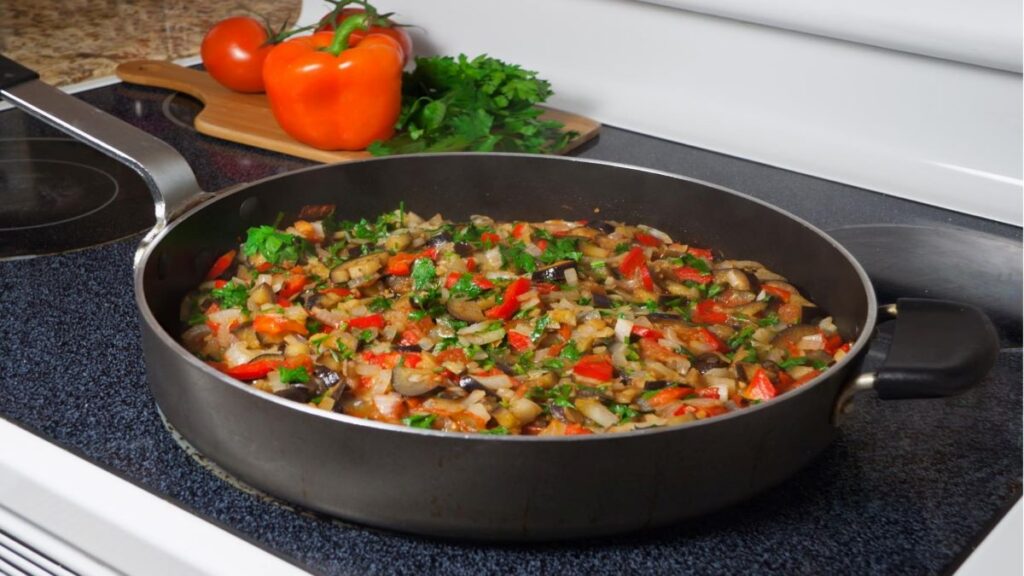Eggplant, Health Benefits, Useful Properties, Calories, Contraindications
Eggplant, also known as aubergine or brinjal, is a popular vegetable used in various cuisines around the world. It is a member of the nightshade family, which includes other vegetables like tomatoes, potatoes, and peppers. Eggplants are known for their unique taste and texture, and they offer numerous health benefits.
Table of Contents
Health Benefits
- Rich in nutrients: Eggplants are a good source of vitamins, minerals, and dietary fiber. They contain vitamins B1, B3, B6, and K, as well as potassium, magnesium, and manganese [1].
Source: [1] https://fdc.nal.usda.gov/fdc-app.html#/food-details/1103231/nutrients
- Antioxidants: Eggplants contain a high level of antioxidants, particularly nasunin, which is found in the purple skin of the vegetable. Antioxidants help protect the body from damage caused by free radicals and can reduce the risk of chronic diseases [2].
Source: [2] https://www.ncbi.nlm.nih.gov/pmc/articles/PMC5613902/
- Heart health: The dietary fiber, potassium, and antioxidants in eggplants can contribute to heart health. Studies have suggested that eggplant consumption may help lower bad cholesterol (LDL) and improve overall heart function [3].
Source: [3] https://www.ncbi.nlm.nih.gov/pmc/articles/PMC4993787/
- Weight management: Eggplants are low in calories and high in fiber, making them a suitable option for people trying to manage their weight. The fiber content can help promote feelings of fullness and aid in digestion [4].
Source: [4] https://www.ncbi.nlm.nih.gov/pmc/articles/PMC4258944/
Useful Properties
- Versatility: Eggplants can be prepared in various ways, including grilling, baking, sautéing, and roasting. They are used in many cuisines, such as Mediterranean, Middle Eastern, and Asian dishes.
- Texture: Eggplants have a unique, spongy texture that can absorb flavors from sauces and seasonings. They can also serve as a meat substitute in vegetarian or vegan dishes.
Calories
One cup (82 grams) of raw, cubed eggplant contains approximately 20 calories [1].
Source: [1] https://fdc.nal.usda.gov/fdc-app.html#/food-details/1103231/nutrients
Contraindications
- Allergies: Some individuals may be allergic to eggplants or other members of the nightshade family. If you experience itching, swelling, or difficulty breathing after consuming eggplant, consult your doctor.
- Solanine sensitivity: Eggplants contain solanine, a natural compound found in some nightshade vegetables. While the levels are generally low, some people may experience gastrointestinal discomfort or other symptoms if they are sensitive to solanine.
Eggplant, The Best Recipe
One of the most popular and delicious eggplant recipes is Eggplant Parmesan, also known as Melanzane alla Parmigiana. This classic Italian dish features layers of eggplant, tomato sauce, and cheese, baked to perfection. Here’s a simple recipe for Eggplant Parmesan:
Ingredients
- 2 medium-sized eggplants, sliced into 1/4-inch (0.6 cm) thick rounds
- Salt
- 1 1/2 cups (375 ml) all-purpose flour
- 3 large eggs, beaten
- 2 cups (500 ml) breadcrumbs (preferably Italian-style)
- 1 cup (250 ml) vegetable oil (for frying)
- 3 cups (750 ml) marinara sauce (store-bought or homemade)
- 2 cups (500 ml) shredded mozzarella cheese
- 1 cup (250 ml) grated Parmesan cheese
- 1/4 cup (60 ml) fresh basil leaves, chopped
Instructions
- Prepare the eggplant: Sprinkle the eggplant slices with salt on both sides and place them in a colander for about 30 minutes to draw out excess moisture. Rinse the eggplant slices and pat them dry with paper towels.
- Set up a breading station: In three separate shallow dishes, place the flour, beaten eggs, and breadcrumbs. Coat each eggplant slice in flour, then dip it into the beaten eggs, and finally coat it with breadcrumbs, pressing gently to help the breadcrumbs stick.
- Fry the eggplant: Heat the vegetable oil in a large skillet over medium heat. Fry the breaded eggplant slices in batches, turning once, until they are golden brown and crispy on both sides (about 3-4 minutes per side). Place the fried eggplant slices on a paper towel-lined plate to drain excess oil.
- Preheat your oven to 375°F (190°C).
- Assemble the dish: In a 9×13-inch (23×33 cm) baking dish, spread 1 cup (250 ml) of marinara sauce evenly on the bottom. Arrange a layer of eggplant slices on top of the sauce, slightly overlapping if necessary. Spoon another cup (250 ml) of marinara sauce over the eggplant, then sprinkle half of the mozzarella and half of the Parmesan cheese on top. Add another layer of eggplant, followed by the remaining marinara sauce, mozzarella, and Parmesan cheese. Finally, sprinkle the chopped basil on top.
- Bake the Eggplant Parmesan: Cover the dish with aluminum foil and bake for 25 minutes. Remove the foil and continue baking for another 20-25 minutes, or until the cheese is melted and bubbly.
- Allow the Eggplant Parmesan to rest for about 10 minutes before cutting and serving. Enjoy with a side of salad or crusty bread for a complete meal.
This delicious Eggplant Parmesan recipe is sure to become a family favorite. The tender, breaded eggplant slices, flavorful marinara sauce, and gooey, melted cheese make for a comforting and satisfying dish.
Final Words
In conclusion, eggplants are a nutritious and versatile vegetable with numerous health benefits. They are low in calories and high in nutrients, making them an excellent choice for a balanced diet. However, some individuals may need to avoid eggplants due to allergies or solanine sensitivity. Always consult your doctor or a registered dietitian for personalized advice regarding your diet.
Read Also:




